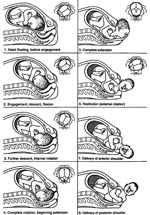1.4 Mechanisms of normal labour
The seven cardinal movements are the series of positional changes made by the baby which assist its passage through the birth canal. (Cardinal means ‘fundamentally important’.) The position before the movements begin is shown in Figure 1.3 (diagram 1) and the seven movements are in diagrams 2 to 8. As you read the descriptions that follow, keep looking at Figure 1.3.

The positional changes made by the baby are specific, deliberate and precise. They allow the smallest diameter of the baby to pass through the mother's pelvic cavity. Neither you nor the mother is responsible for these positional changes. The baby has the responsibility for the seven cardinal movements.
1.3.4 Fourth stage of labour
